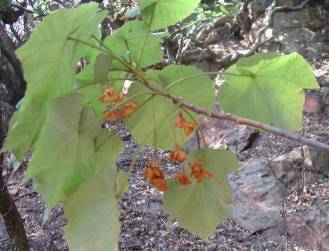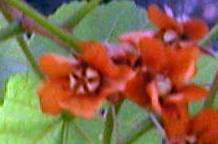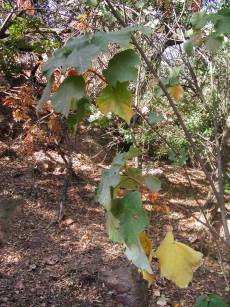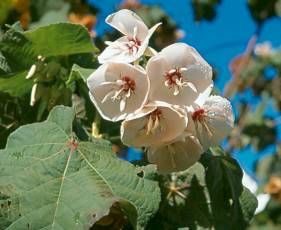Dombeya pulchra
Dombeya pulchra N.E.Br.
Family: Malvaceae
Common names: silver white pear (Eng.); blombos (Afr.)
SA Tree No: 470.1
Introduction
The silver white pear is a beautiful shrub or small tree ideal for the wooded or semi-shaded areas of your garden.
Description
Description
This plant can be classified as a shrub or small tree of up to 5 m in height depending on the area it occurs in. It is multistemmed and the slender branches are smooth, wrinkled and often covered with glandular hairs.
The velvety leaves vary in size from 40 to 200 mm in diameter, are roundish to roughly triangular with the upper half sometimes lobed. The tips are pointed, the bases deeply indented and the margins roundly toothed with 5-7 prominent veins that arise from the base on the lower surface. The upper surface of the leaves is green and covered with short, dense hairs, whereas the undersurface is covered in silvery or greyish white, velvety hairs.

The velvety buds open into white flowers that often display a deep pink centre. They turn brown later. The flowers are borne on hairy stalks in bunches in the axils of the upper leaves. Flowering time: December to May. The fruit is a capsule and is covered with dense, yellowish hairs. The seeds are small, brown and pitted and are ripe between March and June.

Distribution and habitat
Distribution description
The silver white pear occurs mainly on the northeastern Drakensberg from Swaziland, through Mphumalanga to the lower parts of Limpopo Province. It has a somewhat restricted distribution, as it grows on rocky hillsides or mountains at high altitudes, in wooded kloofs or in wooded areas along stream banks.

Derivation of name and historical aspects
History
The generic name Dombeya, is in honour of Joseph Dombey, a French botanist and traveller in Peru and Chile (1742-1793). The specific name pulchra comes from the Latin word for beautiful.
This species is very similar to Dombeya burgessiae that has white or pink flowers with a distribution that overlaps in some areas.
Uses
Use
It is used as an ornamental plant by the nursery trade. Other species often grown in gardens include Dombeya rotundifolia and Dombeya autumnalis.
Growing Dombeya pulchra
Grow
It is easily raised from seed, which can be sown in early September. It is fast growing under garden conditions. This plant can be grown in the more woody or semi-shaded areas of your garden.
References
- Coates Palgrave, K. 1977. Trees of southern Africa. Struik, Cape Town.
- Jackson, W.P.U. 1990. Origins and meanings of names of South African plant genera. University of Cape Town Ecolab, Rondebosch, Cape Town.
- Palmer, E. & Pitman, N. 1972. Trees of southern Africa covering all known indigenous species in the Republic of South Africa, South-West Africa, Botswana, Lesotho & Swaziland, vol. 2. Balkema, Cape Town.
- Van Wyk, B. & Van Wyk, P. 1997. Field guide to trees of southern Africa. Struik, Cape Town.
- Van Wyk, P. 1984. Veldgids tot die bome van die Nasionale Krugerwildtuin. Struik, Cape Town
Credits
Karin Behr
Pretoria National Botanical Garden
August 2005
Plant Attributes:
Plant Type: Shrub, Tree
SA Distribution: Gauteng, KwaZulu-Natal, Limpopo, Mpumalanga
Soil type: Sandy, Loam
Flowering season: Late Summer, Autumn
PH: Neutral
Flower colour: White
Aspect: Full Sun, Shade, Morning Sun (Semi Shade), Afternoon Sun (Semi Shade)
Gardening skill: Average
Special Features:
Horticultural zones










Rate this article
Article well written and informative
Rate this plant
Is this an interesting plant?
Login to add your Comment
Back to topNot registered yet? Click here to register.